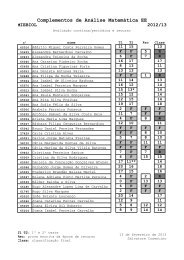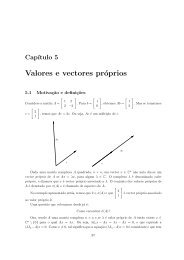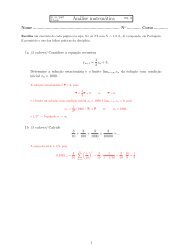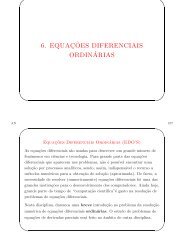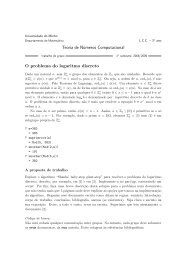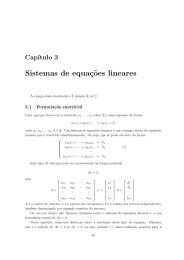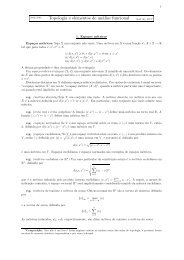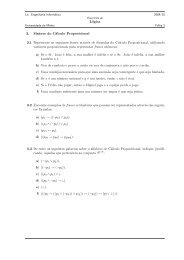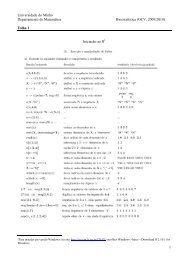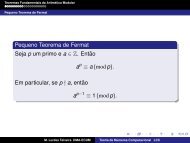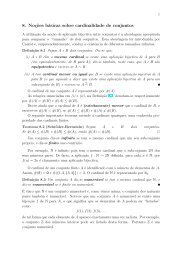My title - Departamento de Matemática da Universidade do Minho
My title - Departamento de Matemática da Universidade do Minho
My title - Departamento de Matemática da Universidade do Minho
Create successful ePaper yourself
Turn your PDF publications into a flip-book with our unique Google optimized e-Paper software.
4<br />
NÚMEROS E DINÂMICA 21<br />
4 Números e dinâmica<br />
“317 is a prime, not because we think so, or because our minds are shaped in one way<br />
rather than another, but because it is so, because mathematical reality is built that way.”<br />
4.1 Expansão <strong>de</strong>cimal e multiplicação ×10<br />
Ref.<br />
[HW59], chapter IX.<br />
G.H. Hardy, A Mathematician’s Apology, 1940.<br />
Expansão <strong>de</strong>cimal.<br />
When children we learn to represent numbers as <strong>de</strong>cimals, like<br />
3.14159265358979323846264338327950288419716939937510 . . .<br />
Of course, there is nothing especial with the number 10, it is but the number of fingers in our<br />
hands. Any other integer d ≥ 2 would <strong>do</strong>. Representing a non-negative (for simplicity) real<br />
number x ∈ R + in base 10 means writing x as the sum of a convergent series<br />
x = X m . . . X 2 X 1 X 0 .x 1 x 2 x 3 . . .<br />
= X m · 10 m + · · · + X 2 · 10 2 + X 1 · 10 + X 0 + x 1<br />
10 + x 2<br />
10 2 + x 3<br />
10 3 + . . .<br />
m∑<br />
∞∑<br />
= X n · 10 n + x n · 10 −n<br />
n=0<br />
n=1<br />
where X n , x n ∈ {0, 1, 2, . . . , 9} and m ≥ 0. Some representations terminate, i.e. have x n = 0<br />
starting from some n ≥ N, and some others are recurring, i.e. of the form<br />
X m . . . X 2 X 1 X 0 .x 1 x 2 . . . x k−1 x k . . . x k+n<br />
(and of course a terminating <strong>de</strong>cimal is a recurring one with recurring word 0). The representation is<br />
unique, hence there is a bijection between R and the space of infinite words X m . . . X 2 x 1 X 0 .x 1 x 2 x 3 . . .<br />
as above, if we <strong>do</strong> not admit recurrent 9’s, i.e. if we substitute . . . x k−1 9 with . . . (x k−1 +1)0 (where<br />
we assume x k−1 ≠ 9).<br />
The finite sum<br />
m∑<br />
[x] = X n · 10 n ∈ Z<br />
n=0<br />
is the integral part of x, the largest of those integers n such that n ≤ x. The possibly infinite sum<br />
{x} = 0.x 1 x 2 x 3 · · · =<br />
∞∑<br />
x n · 10 −n ∈ [0, 1)<br />
is the fractional part of x, the difference {x} = x − [x]. Consequently, [x] + {x} = x.<br />
Division algorithm. The iterative scheme to obtain the <strong>de</strong>cimal representation of a rational<br />
number is the “division algorithm” that we learn when children. Consi<strong>de</strong>r a positive rational<br />
number x = p/q with p, q ∈ N:<br />
p<br />
q = x 0.x 1 x 2 x 3 . . . .<br />
The integer [x] = x 0 is “the number of times q is contained in p”, i.e. the unique integer such that<br />
n=1<br />
p = x 0 · q + r 0<br />
for some rest r 0 which is an integer 0 ≤ r 0 < q. Hence, p/q = x 0 + r 0 /q and 0 ≤ r 0 /q < 1. The<br />
“geometric” meaning of x 1 is that the point r 0 /q lies between 0.x 1 and 0.x 1 + 0.1. Multiplying by<br />
10 and then by q this means that<br />
x 1 · q ≤ 10 · r 0 < x 1 · q + q



